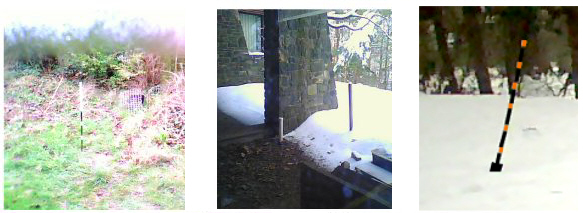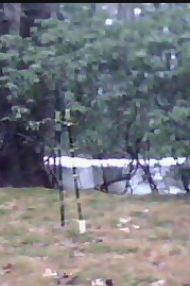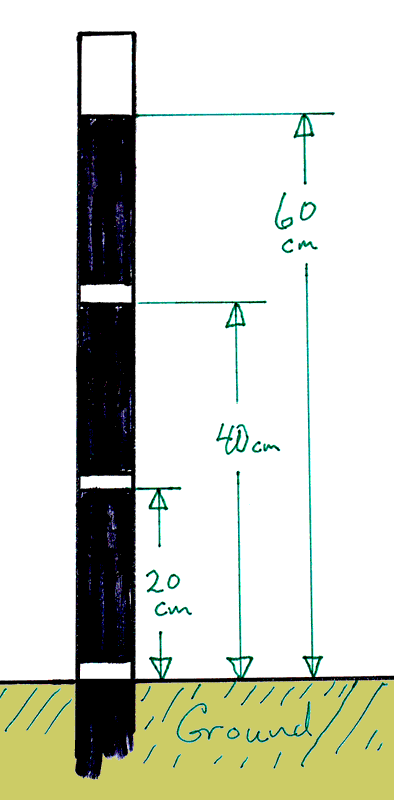
 Bookmark this on Delicious
Bookmark this on Delicious
 Recommend at StumbleUpon
Recommend at StumbleUpon
Serious snowfall recording is not for the faint-hearted! Even simply detecting the presence of snow is tricky.... but all that just makes it more fun, doesn't it?
You need to overcome the problems caused by drifting. If you want to know how much water is in the snow, you need either to melt the snow as it falls or measure the weight of the snow.... without letting the winds which often accompany snowfall disturb your reading. And you may have wet equipment, which is about to freeze up. Hmm.
I haven't got "the answer" for you... but I do have some thoughts which might help you on your way, and I also have a partial answer.
If you simply want to measure the amount of water in that snow, see my measuring rainfall page.) But for the depth of fallen snow maybe an ultrasonic ranging devices could be used to detect the top of the snow, from which depth could be calculated. There used to be LOTS of Good Stuff in the discussion group at Dalsemi (http://lists.dalsemi.com/search/search.html), but that seems to have died. I'll bet there are discussions at the Arduino forum, though.... and if not, you could start some!
I'll give you my partial answer to measuring snow depth in a moment. It will let you detect snow depth at a given location from anywhere on the internet, but it won't be able to record the measurement in a data file. See if you can come up with something to do that before you get to my answer!
In any design task, it is a good idea to think carefully about where you are going before you travel very far down any particular road.
What do we mean when we say our instrument will "measure the snow"?
Are we trying to measure how many inches of snow fell? How many grams of snow? They aren't the same thing, are they? (In all of this, you should infer that I am including "per square meter of earth surface", of course.)
Inches of snow would tell the reader what the landscape looks like, and whether ankle, knee or thigh-high boots are needed.
But 25 cm of fluffy snow, when it melts, delivers a lot less water than 25 cm of heavy snow.
The rest of this page talks about trying to measure the depth of the snow which has settled on the ground. (By all means write in and ask for thoughts on other snow measurements, if you find them interesting, or if you have some interesting thoughts to share here.)
Note the approximation I have decided to pursue: I'm not trying to measure how much snow fell... I am going to settle for how deep is the snow now, forgetting the snow that fell and melted, to get the ground cold enough that the next bit of snow didn't melt. In some areas, significant amounts of snow are lost to sublimation, once the snow has fallen, so the fact that today there is 25cm of snow, and last week there was 25cm of snow doesn't mean that there's been no new snow, does it? You begin to see, I hope, how snow is uncooperative?
If you are measuring wind speed or wind direction, you must take a little care in siting your instrument. But finding a suitable spot isn't too hard in most circumstances.
The wind doesn't "drift" in the sense that snow drifts.
Depending on the approach you take to measuring snow, you have to take great care where you site your instrument, and with the nature of the instrument. You want typical depth, I presume... not a too low number from a wind-swept spot, nor a too high number from where a snow-drift has formed. Remember that your instrument itself may influence drifting.
Just before I get to my partial answer, I am going to digress, and point out that if "how much" snow has fallen in what is perhaps the most significant sense, can be measured quite easily if you can find a way to heat the collecting funnel of a standard rainfall measuring device. This measurement will also have the virtue of "catching" the snow which falls on the ground and melts, in the days when you are making the transition from bare fields to snow covered fields.
If you just want to see, but quantitatively, how much snow is lying on the ground, "all" you need is a stick and an IP camera! (If only arranging for the IP cam were as easy as arranging for the stick!)
There's an example on the web at...
.. in the picture at the upper left. Just to the left of the center, you should be able to see a piece of white plastic pipe (electrical conduit) with three black bands painted on it. This image was created in southern England.
You should also be able to see, upper right, an image from between New York and Boston in the USA. It has a "stick" in it, too, but badly sited, and without measuring marks on it. But that site more often has snow! I'll do something about a better stick when I can!
Here are three "historical" images, in case you are reading this page in July, or you don't want to take a chance on the link above, or it isn't working, or.... !
The one on the right has been modified with Serif's excellent PhotoPlus, to show the bands in orange even though they are white in the images the camera harvests. The wide bit at the bottom is the "blades" on a metal fence-post. So... at the time that image was taken (Feb 18,2014, southern Connecticut), the snow was quite deep... the bottom 8 inches or so being in the snow, not buried in the ground!

.. and a more recent image of the right hand one, which has had a second one "appear" to the right of it...

If you set about making your own snow stick, bear in mind that at the most interesting times, the bottom part of the stick isn't visible. Make it easy for viewers to know how much is buried, but from some distinctive band, or maybe a digit, near the top of the stick.
(Please write and complain, if the images on the near-live webpage don't correspond to the "historic" images.)

These things probably would have occurred to you, but, to save you cursing the acuity of hindsight, and to give you the calibration of my snow stick....
With any weather monitoring sensors, usually, it pays to take the time to Do It Right The First Time. Being out in the wind, rain, sun, will soon get the better of any corners you cut. However, with a snow stick, it will probably be best to do a simple mock up, for brief trials, to determine if the sizes you have used suit your particular situation. But, after that test, do take trouble over how you make your snow stick... unless you want to be doing it all again far too soon.
A simple thought: You want most of the stick to be black... so you can see how far up it the white snow comes.
Not so simple: We are used to white rulers with black marks on them. A "negative ruler", with white marks has been giving my intuitive use of it some brain-ache. Especially as the edge of a wide band of white is the "place you measure to".
With an ordinary ruler, we measure to a line, and ignore the fact that the line has some width.
Make thin bands of white on your snow-stick, and you may have trouble seeing them unless your IP cam has better resolution than mine does. Put the snow stick near the camera, and you will get problems of snow accumulation when the snow drifts... the stick ought to be "out in the open", away from other things.
If you make the bands of black and white of equal width, half the time the top of the snow will be in a white band, and hard to see. Maybe the answer is to make your snow stick, say, orange and black? Then equal width bands would be okay... but that means more painting, perhaps. But not if you find a suitable black plastic pipe for the stick.
The diagram at the right shows how I marked my snow stick. Be sure to mark where "zero" is, so that when you set up the stick, you know how far to drive it into the ground!
I used a piece of white plastic electrical conduit pipe. A little bit of work with masking tape and spray paint, and I was done. (Before you start, give the pipe a quick rubbing over with fine sandpaper to clean it, and help the paint adhere.)
You might want to use pipe of a larger diameter, especially if the snow stick isn't going to be as close to your camera as mine is.
Divide and conquer: I made my snow stick out of a single piece of pipe, putting my bands "up" from the end of the pipe, so that I could drive the "bottom" part of the pipe into the ground. A better design might be in two parts: A stake of suitable proportions... a bit of re-bar?... driven into the ground, and a snow stick made of pipe, with "zero" at the end of the pipe, which slips over the stake. I was lucky with the ground I had to work with, it wasn't too hard to force the plastic pipe into it. Harder ground, or a fatter pipe, and I would have had problems. The two part design also means that the stake can be driven pretty well as far into the ground as seems best. The one part design forces you to use a particular length of "in ground" pipe.
Even entry- level IP cams usually allow the user to cause them to send a copy of what they see to an FTP server periodically. It can't be too hard (?!) to write a bit of software to "look at" the image, measure the extent of the black bands visible in them. If someone takes up that challenge, I hope they will do the job in a way that makes the result easy to integrate with other programs. I would suggest that the "read image" program not be too fancy... returning the width of the bands in arbitrary units, and leaving conversion to standard units (e.g. cm) to "outside" programs. The "read image" program should, my view, have an ini file which tells it....
It would be reasonable to expect that the scene would not change from image to image. There should be some mechanism for telling the "read image" program roughly what part of the scene holds the snow stick.
The output, in the small text file, might be as simple as...
Image date/time: 2014-02-07/15:48 Top band: 35 next:35 next:17
The values I've given are for what the "read image" should return if looking at one of my sticks, with 10cm of snow on the ground... i.e., enough to cover the lower half of the first band.
(I'd suggest that the "read image" program should report the date/time in a strictly "fixed" format... always the same length, regardless of the date or time. All that's needed is leading zeros, as shown in the example. (Eight minutes past nine AM would be 09:08. Eight past nine, PM, would be 21:08). Details, details! But they matter!)
For a long time now (Feb 14), there has been a careful, thorough discussion with circuits and links available. This does use 1-Wire devices, but there is much information here for the non 1-Wire worker, too.
If you want to send me links to other hobbyist "answers", they are always welcome!
![]() Page tested for compliance with INDUSTRY (not MS-only) standards, using the free, publicly accessible validator at validator.w3.org
Page tested for compliance with INDUSTRY (not MS-only) standards, using the free, publicly accessible validator at validator.w3.org